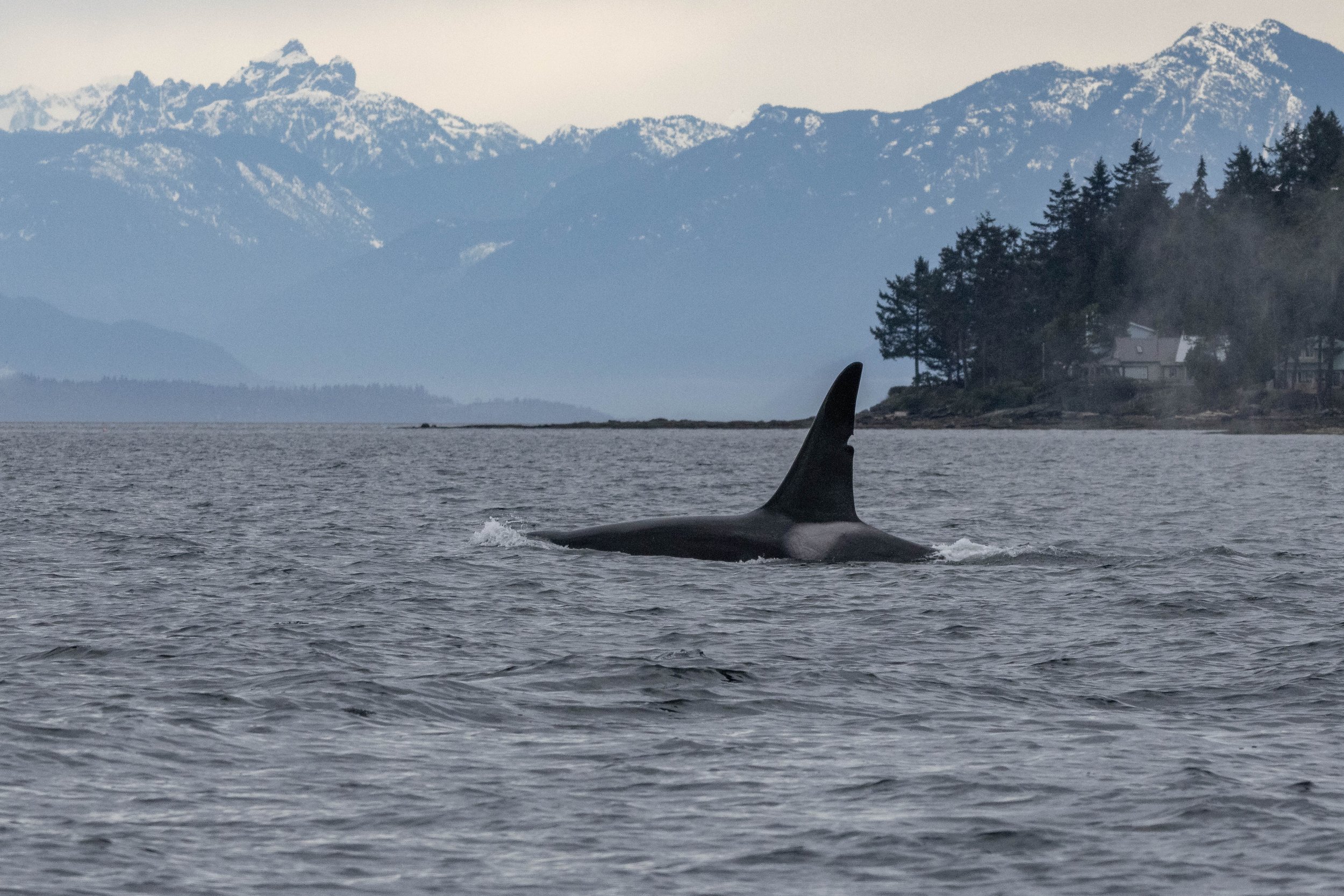March 26, 2025 - T-party in Northumberland Channel
Although our boat left the dock a few minutes late on the afternoon of March 26th, the timing turned out to be perfect, as we received word of orcas spotted from shore not too far from Nanaimo. In fact, within about 10 minutes of departing, we managed to spot the huge black dorsal fins of a pair of bull orcas, accompanied by several smaller fins in the mix.
The six-foot-tall dorsal fin of an adult male can make identification slightly easier for the onboard naturalist, given the large surface area for nicks or scars. With these two boys, it was immediately obvious who they were, thanks to a giant notch in the middle of one fin and a pair of smaller notches toward the bottom of the second. It was the Alaskan Brothers! Flotsam and Jetsam are almost always travelling together, but they don’t typically have the same companions for long. After referencing some of our photos, we determined that today they were travelling with the T030Bs and T117Bs. That means the following whales were present:
T030B Lyra ♀ (1993)
T030B1 Vega (2012)
T30B2 Capella (2017)
T030B3 (2024)
T117B ♀ (2005)
T117B1 (2023)
T128 Flotsam ♂ (1988)
T125A Jetsam ♂ (1998)
Interestingly, the T030Bs and T117Bs have been seen travelling together for over half a decade—long before T030B3 and T117B1 were born! There is currently no known genetic relation between the two matriarchs, but they share a tight social connection. Relationships like this one are quite common, although research is still being conducted to understand what benefits these associations might provide beyond apparent companionship. Other whales are known for similar behaviour, often having “best friends” they travel with. Perhaps one day, as both matriarchs have more offspring and their growing numbers become too conspicuous to prey, we will see them travelling together less frequently. But for now, it’s always a pleasure to witness these social bonds.
The Brothers, on the other hand, are likely socializing here with one goal in mind: breeding. It has long been theorized that when whales not commonly seen in an area show up for brief periods, it may be a way to maintain high genetic diversity in the population. If a population becomes isolated and has a smaller pool of genetically distinct individuals, genetic variation can decline. This loss of variation can cause problems, as genetic differences are crucial for species survival during times of environmental change. Fresh genetic material introduced through whales like these two males—who are more commonly spotted in northern BC and Alaska—helps maintain this diversity. With climate change posing an ever-looming threat to the oceans, high genetic diversity gives species like orcas the best chance of adapting to these changes.
Soon, our time with these whales came to a close, and we decided to head south. Travelling over smooth seas with the Coastal Mountains and Southern Gulf Islands framing our view, we arrived at the south end of Gabriola Island, home to a well-known sea lion haul-out. Today, Steller Sea Lions were jostling for position on the rocks in the rain. Like orcas, Steller Sea Lions exhibit sexual dimorphism, meaning males and females look quite different. The 2,800-pound males are the easiest to spot, as they are a full 2,000 pounds heavier than a fully grown female. This time of year, not all the smaller ones are females—there is also a mix of juveniles sharing the rocks with the adults.
From the haul-out, we took the inside route through the Southern Gulf Islands to travel home, weaving through smooth waterways until we reached our final stop: the Gabriola Bluffs. These bluffs are starting to buzz with activity as spring emerges in BC. Their typical inhabitants, the cormorants, are beginning to return to these towering sandstone cliffs to nest, repairing the nests they built in previous years. We saw several Pelagic Cormorants in their iridescent breeding plumage on the cliffs, along with a pair of gulls nearby. Just before we left, we spotted one last bird perched atop a nearby tree—a Bald Eagle! Seeing its striking white head and tail feathers was the perfect way to end the day as it carefully watched us from high above.
Throughout the tour, onboard Marine Naturalist Vanessa Vereschagen captured photos of all the wildlife we encountered—the best of which you can enjoy below!
T125A Jetsam surfacing in the waves.
The Alaskan Brothers: T128 Flotsam and T125A Jetsam surfacing together.
T128 Flotsam and T125A Jetsam surfacing together.
T125A Jetsam surfacing with Gabriola Island behind him.
A great look at T128 Flotsam as he surprised us, surfacing a little closer.
T030B1 Vega surfacing in front of their mom, T030 Lyra and younger sibling, T030B3.
T030B1 Vega, T030 Lyra, and T030B3 surfacing together.
Look at all the scars on T117B’s saddle patch!
T030 Lyra surfacing with her youngest offspring, T030B3, born last year.
From left to right we have T030B3, T030B2 Capella, and T117B surfacing together.
T128 surfacing on his own.
T125A Jetsam (shown here) and the rest of the group snuck up on this kayaker who was trying to fish!
Just look at the size difference between T125A Jetsam and the kayaker. Reminds you how giant orca really are!
T030B1 Vega, T030 Lyra, and T030B2 Capella surfacing together in the rain.
Fighting breaks out among the sea lions at stinky rock.
The rain didn’t bother this big adult male Steller Sea Lion.
You can see the Steller Sea Lions don’t have much regard for personal space.
A cuddle puddle in the rain.
A Pelagic Cormorant in breeding plumage at the Gabriola Bluffs.
A pair of gulls overlooking the Gabriola Bluffs.
Fluffing up after preening their feathers!
A moody look at the sandstone cliffs of the Gabriola Bluffs.
A rather undignified view of this Bald Eagle.
“Undignified? How rude”
























